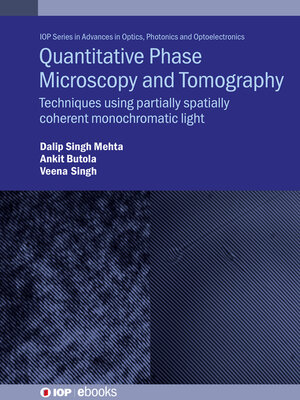Quantitative Phase Microscopy and Tomography
ebook ∣ Techniques using partially spatially coherent monochromatic light
By Dalip Singh Mehta

Sign up to save your library
With an OverDrive account, you can save your favorite libraries for at-a-glance information about availability. Find out more about OverDrive accounts.
Find this title in Libby, the library reading app by OverDrive.



Search for a digital library with this title
Title found at these libraries:
| Library Name | Distance |
|---|---|
| Loading... |
Quantitative phase Microscopy (QPM) has become an important imaging technique in biology for investigating cells and tissues. QPM is an optical interference or holographic microscopic technique in which an input light beam is divided into two beams and one passes through the object and the other acts as a reference beam. This book develops and describes the most advanced QPM techniques and computational imaging techniques using partially spatially coherent monochromatic light rather than highly coherent lasers. Using partially coherent light as a light source instead of a traditional laser has significantly improved QPM imaging results. Imaging techniques that will be discussed include speckle-free QPM both off-axis and common path interferometric configurations, structured illumination phase microscopy (SIPM), chip-based nanoscopy, machine learning, deep learning and artificial intelligence (AI) in phase microscopy and OCT and multi-spectral and hyper-spectral phase microscopy. Coherent-noise free QPM techniques described in this book lead to an order of magnitude improved spatial phase sensitivity, space-bandwidth product, and high temporal phase stability. The technique was utilized for sperm cells, macrophages, liver sinusoidal endothelial cells, cancer cells and red blood cells for precise QPM. We have demonstrated that partially spatially coherent monochromatic light is a most suitable source for high precision QPM. The text is highly useful for biologists, optical engineers, optical scientists, researchers working in QPM and OCT, and graduate and post graduate students. Part of IOP Series in Advances in Optics, Photonics and Optoelectronics.
Key features







